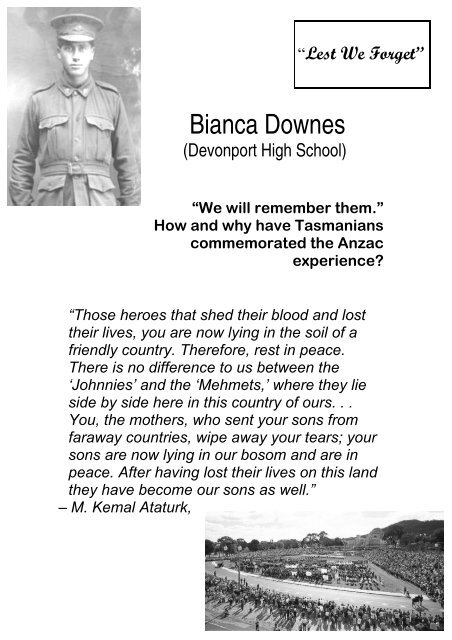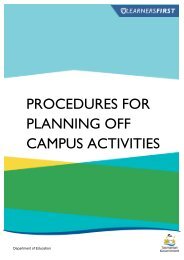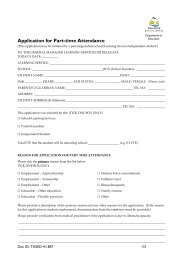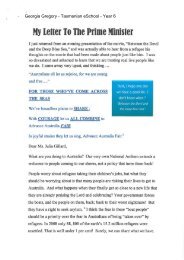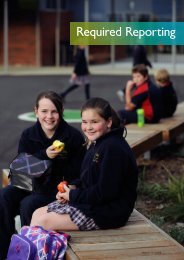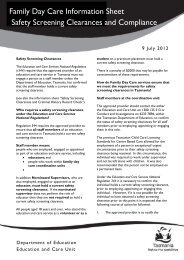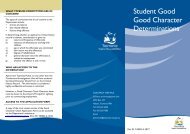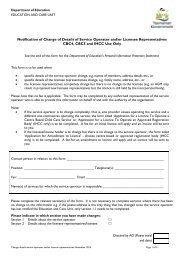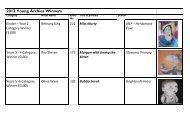Bianca Downes
Bianca Downes
Bianca Downes
- No tags were found...
Create successful ePaper yourself
Turn your PDF publications into a flip-book with our unique Google optimized e-Paper software.
“Lest We Forget”<br />
<strong>Bianca</strong> <strong>Downes</strong><br />
(Devonport High School)<br />
“We will remember them.”<br />
How and why have Tasmanians<br />
commemorated the Anzac<br />
experience?<br />
“Those heroes that shed their blood and lost<br />
their lives, you are now lying in the soil of a<br />
friendly country. Therefore, rest in peace.<br />
There is no difference to us between the<br />
‘Johnnies’ and the ‘Mehmets,’ where they lie<br />
side by side here in this country of ours. . .<br />
You, the mothers, who sent your sons from<br />
faraway countries, wipe away your tears; your<br />
sons are now lying in our bosom and are in<br />
peace. After having lost their lives on this land<br />
they have become our sons as well.”<br />
– M. Kemal Ataturk,
“WE WILL REMEMBER THEM.” HOW AND WHY HAVE<br />
TASMANIANS COMMEMORATED THE ANZAC EXPERIENCE?<br />
“Bury the Body – It has served its ends.<br />
Mark the spot, lest ‘on Gallipoli,’<br />
Let it be said he died Oh!<br />
Hearts of friends<br />
If I am worthy, keep my loving memory.” 1<br />
The ANZACs are certainly worthy of our memories. The ANZAC experience is a defining part of our<br />
history. Every community in Tasmania commemorates this on, and leading up to, April 25th with<br />
remembrance marches, services and sporting events. Every school has an annual ANZAC assembly.<br />
Communities have created memorials to remind us. The ANZAC experience brought Australia<br />
together as a nation and gave future generations ideals to strive for.<br />
Respect for the ANZAC experience is evident in that it is a national Public Holiday. At the Premiers’<br />
Conference in Melbourne in 1921 it was agreed that “irrespective of the day it falls, ANZAC Day<br />
should be observed on the 25 th April of each year, and that the holiday should be a uniform one<br />
throughout the States.” 2 The Commonwealth Parliamentary Papers of the 1923 Premiers’<br />
Conference include the following proposal “the morning of the day to be observed by the<br />
holding of religious and memorial services. The afternoon to be devoted to the giving of<br />
suitable addresses and instilling into the minds of children the significance of ANZAC Day.” 3<br />
These traditions continue today. In every community on April 25 th businesses and schools are<br />
closed. Families and individuals attend and participate in dawn services, marches, remembrance<br />
ceremonies and the many other rituals that are a part of this day. Crowds line streets to applaud<br />
those who have participated in conflicts around the world and people take the time to remember<br />
and appreciate our freedom, gained from the sacrifices of others.<br />
The first ANZAC sports day was held in the Australian camp, Egypt in 1916, an opportunity for<br />
soldiers to relax and recuperate. 4 ANZAC Day Sports became a tradition as returned servicemen ran<br />
them for children in their communities. In Latrobe, the Council has reintroduced ANZAC Day Sports.<br />
This aims to retain the tradition and encourage in participating children the development of the<br />
ANZAC ideals of resilience, mateship and striving to do one’s best. Another ANZAC Day sporting<br />
event is the traditional clash between Australian Football League teams Collingwood and Essendon.<br />
The Northern Tasmanian Football League has replicated this. For the last two years Devonport and<br />
East Devonport have played on ANZAC Day, returned servicemen receive free entry as a mark of<br />
respect.
Every school in Tasmania holds an ANZAC assembly for students to pay their respects. Veterans<br />
attend and students participate in organising and running the event. Included are ANZAC Day<br />
rituals such as the Last Post, wreath laying and one minute’s silence. At my primary school,<br />
Spreyton, the assembly is held in the ANZAC garden which features an ANZAC mural painted by<br />
students and a commemorative plaque. The President of the local Returned and Servicemen’s<br />
League (RSL) spoke each year. At my high school this year James Holden, a previous Frank<br />
McDonald Memorial Prize winner, spoke about his trip to Gallipoli. These ceremonies enhance<br />
students’ understanding and respect for the ANZAC experience.<br />
Tasmanian communities feature ANZAC memorials. At Ringarooma in 1918, nine trees were<br />
planted to honour the soldiers that died in WWI. 5 One represented the ANZACs, another, the battle<br />
of Gallipoli. In 2001, the trees were deemed too dangerous to leave standing. The council hired a<br />
sculptor who carved each stump into a memorial for a soldier from the area. The ANZAC tree<br />
features the ANZAC Cross, the Battle of Lone Star and the Australian Flag. The Gallipoli tree<br />
portrays a WWI soldier. At Ulverstone, ANZAC Park is one of the main recreational areas of the<br />
town. The park features gardens named after battles and trees planted as memorials. One of the<br />
trees is an Aleppo Pine; the same as the trees at Lone Pine. These examples clearly demonstrate the<br />
Tasmanian community’s dedication to honouring the ANZAC experience.<br />
Why do young people commemorate the ANZAC experience? Young people do so because many<br />
who served were so young. We admire their strength in enlisting; their resilience and endurance.<br />
We wonder how testing the ordeal was for such young bodies and minds.<br />
“Their uniforms were torn, their knees broken. They had had no water since the morning,<br />
they could talk only in whispers; their eyes were sunken… [Yet] not one had dreamed of<br />
leaving his post.” 6<br />
We question if we, faced with similar circumstances, could find the same qualities in ourselves.<br />
The ANZAC experience created intense national pride for what Australians had achieved. Although<br />
8 709 were killed and 18 235 wounded, it wasn’t seen as a failure. 7 The ANZACs faced war; thick<br />
with suffering, pain and fear with courage, determination and good humour. We admire this. It gave<br />
Australians belief in themselves. Pride united the people of Australia as a nation. In 1915, famous<br />
Australian poet Banjo Patterson wrote to the ANZACs of this:<br />
“The old state jealousies of yore,<br />
Are dead as Pharaoh’s sow,<br />
We’re not State children anymore,<br />
We’re all Australians now!” 8
Personal experiences of war passed down though family stories create a sense of connectedness to<br />
the ANZAC experience. My grandfather tells of his brother, my great‐uncle Arthur Wright, a<br />
prisoner‐of‐war who was shot while escaping across the Rhine to freedom, of my greatgrandmother’s<br />
immense suffering when just one of her three sons returned from war. Such stories<br />
have been told since the ANZAC campaign. The grief endured by our own forebears encourages us<br />
to continue to honour their memory.<br />
The ANZAC experience is a significant chapter in Australian history. It is so symbolic some argue<br />
ANZAC Day should replace Australia Day. 9 The ANZACs are commemorated by Tasmanians on<br />
ANZAC Day and through community memorials; lasting reminders of their sacrifice. Their<br />
contribution shall never be forgotten.<br />
“They shall not grow old, as we who are left grow old;<br />
Age shall not weary them, nor the years condemn.<br />
At the going down of the sun and in the morning<br />
We will remember them.” 10<br />
i<br />
1. Spent, J, Gallipoli 1915, ABC Books, Sydney, April 2002 p.2<br />
2. Commonwealth Parliamentary Papers,1920‐21 No 156, Volume 4, p.2<br />
3. Conference of Commonwealth and State Ministries, Melbourne, May‐June 1923, No 493, p139<br />
4. Australian War Memorial. The ANZAC Day Tradition. Australian War Memorial. [internet] 1997 ‐2007<br />
5. Dorset eCentre. Legerwood Memorial Trees. Tasmanian Communities Online [internet] 2005<br />
6. Bean, C.E.W, Gallipoli 1915. ABC Books, Sydney, April 2002, p.44<br />
7. Returned and Services League Of Australia. “ANZAC Day” [internet] 2001<br />
8. ibid.<br />
9. Rex, J, Anzac Day Is When We Became One, The Advertiser, Adelaide, March 20 th 2007<br />
10. Binyon, L , For The Fallen, 1914
Bibliography<br />
Websites:<br />
ANZAC Day commemoration committee “ANZAC Day” [internet]<br />
h ttp://www.anzacday.org.au/ (Visited 2007, May 26)<br />
ANZAC Day Commemoration Committee “Words Of Remembrance” [internet]<br />
h ttp://www.anzacday.org.au/education/tff/rememwords.html (Visited 2007 May 26)<br />
Australian War Memorial “The Dawn of The Legend” [internet]<br />
h ttp://www.awm.gov.au/dawn/plan/eightmonths.asp (Visited 2007, May 13)<br />
Culture and Recreation Portal, “ANZAC Day”, [internet]<br />
h ttp://www.acn.net.au/articles/anzac/ (Visited 2007, May 13)<br />
Culture and Recreation Portal “The Last Post” [internet]<br />
h ttp://www.cultureandrecreation.gov.au/articles/anzac/lastpost.htm (Visited 2007, May 13)<br />
State Library South Australia “ South Australians at War” [internet]<br />
h ttp://www.slsa.sa.gov.au/saatwar/collection/transcripts/D7720L_1.htm (Visited 2007, May 23)<br />
The Age Company. “Gallipoli In their Own Words.” [internet]<br />
h ttp://www.theage.com.au/articles/2004/04/17/1082140118215.html (Visited 2007, May 21)<br />
Age Company, the “Nation pays Tribute to ANZACS” [internet]<br />
http://www.theage.com.au/news/national/teens‐vandalise‐warmemorial/2007/04/25/1177180689958.html?page=3<br />
(Visited 2007, May 13)
Newspapers:<br />
Catchpole,H. “Historic” The Advocate, Monday November 15, 2004<br />
King, J. “The Grand Old Man Of Gallipoli” The Weekend Australian. June 23 -24 200<br />
King, J. Montgomery, B. Stewart, . “The Last Anzac” The Weekend Australian June 23-24 2001<br />
Pink, K. Vowles, G. ‘Century Of Change; Souvenir Edition’ The Advocate. January 1, 2000<br />
Books:<br />
Carthew, N, Voices From The Trenches, New Holland Publishers, Australia, 2002<br />
King, J. and Bowers, M. Gallipoli; A 90 th Anniversary Tribute, Doubleday, Australia, 2005<br />
Lewis,R. and Gurry, T. Australians at War, Secondary schools education resource, Impact printing Ltd.<br />
Melbourne, 2002.<br />
Reid, R. Gallipoli 1915, ABC Books, Sydney, April 2002<br />
DVDs:<br />
Colours of war, The ANZACS, Film Australia, Australia, 2004<br />
Gallipoli, Australian Film Commission, Australia, 1981
Images from cover page:<br />
Frank MacDonald.<br />
Pyke, P. “The Last WW1 veteran dies” Army, The Soldiers Newspapers, (Visited 2007, March 26)


